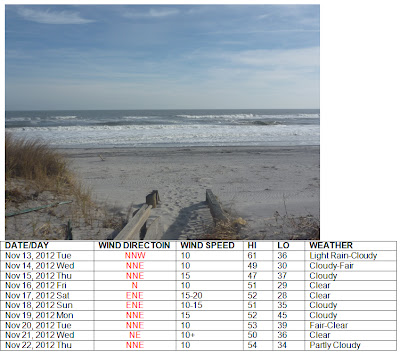 |
| NE wind, again, fair weather NE wind, AGAIN |
What's the wind? Northeast. Hey, how was Long Beach Island? Uhh, damp and dreary the wind was northeast, again. Hybrid-storm Sandy had N and NE wind, and was followed by another low pressure with N and NE wind. Now, since at least Tuesday the 13th, the wind has been from the N to ENE for 8 consecutive days, and is forecast for one more. There is one area in the world where something like this would not be too unusual, which is the tropics. Where the trade winds blow it's like NE today, E tomorrow, NE the next day. The only thing that swings the wind around to the W in the tropics is a hurricane. See, I look at the houses on pilings that look like North Carolina, flat beaches where there never used to be, and day after day of NE winds right now. And then I would go fishing or something, but I can't do that.
 |
| High pressure NE winds |
 |
| When I saw this weather map midday with the storm due in the evening, I quietly said oh **** |
I usually don't like to make guarantees, but I have confidence in saying no one really 'heard about' the giant fetch of E winds over the Atlantic Ocean due to a blocking, or stuck, high pressure near Greenland, of which Sandy was only a part. It wasn't just Sandy bringing in the water- NE winds behind the storm extended across nearly the entire Atlantic Ocean from Ireland to New Jersey. The only other time I saw a map with that was from the 1962 Great Atlantic Storm- but that was a high pressure and one HUGE storm. This was a high pressure and three smaller storms, one of which was giant, including Sandy, a low in the central Atlantic, and a front moving through the United Kingdom. I was aware of all this stuff when I saw this map midday on Monday, when the waves were still hitting the dunes at low tide, and the highest storm surge was going to hit exactly at a full moon high tide. And it wasn't just Sandy coming in- it was 3,000 miles of Atlantic Ocean.
 |
| There was a reason the play on words 'Frankenstorm' was being used to describe Sandy. Compare the image of Sandy as a 'hurricane' with 1989 Hurricane Hugo as a hurricane. |
So there was a high pressure that was stuck near Greenland forcing the entire Atlantic from Ireland into New Jersey. And then there was a storm that was one of the most confused mass of rotating wind and clouds ever observed. And now, the wind is stuck out of the NE day after day, and is forecast to be NE for the 9th consecutive day, tomorrow. And I can't go fishing or surfing right now, so I am forced to put a lot of my energy into the weather, which is needed to break the patterns that it keeps getting stuck in, however, I don't believe I am the one that could provide all that force. It takes a lot of people who have their head in the correct place to get an anorexic to eat again, or to get a 799lb person not to eat again. And it takes even more to get those people to eat correctly and have happy lives, but it is possible. It takes a lot of people to break their own patterns to get high pressure systems to move again, and to not have the wind NE for 9 days in a row pushing the waves back under broken houses on pilings.
 |
| Change the tempo, but never miss a beat. If the wind is going to be NE a lot, I will use it to my advantage. |
I believe in some hocus-pocus that no matter how horrible things are or seem to be, there is always an opportunity to make things better, and that a choice to make things better is available every moment. So long as you are not dead, you have the choice of making this world around you more vibrant, energized, healthy, and a wonderful place. Or there is the option of having the wind get stuck from the NE for 9 days, one week after a northeaster and a hybrid storm with NE winds, and you can have NE wind every day so that the remainder of the crumpled houses get washed away into the ocean. There is the option of making people cry because their house is gone or because the bills to clean the first floor are through the roof. Another option is to knock a person's house down, not tell them why or who did it, and then give them some checks and a handshake. These are the times that try men's souls.







































































